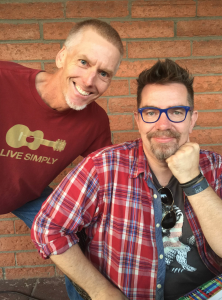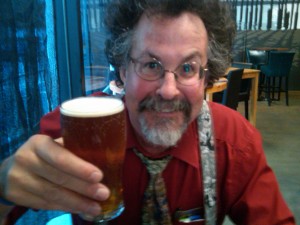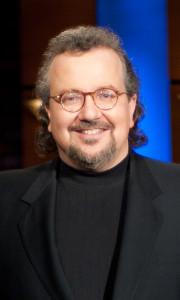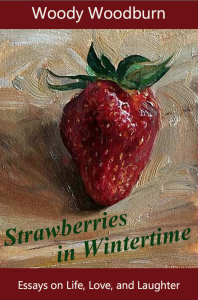 Woody’s highly anticipated new book “STRAWBERRIES IN WINTERTIME: Essays on Life, Love, and Laughter” is NOW available! Order your signed copy HERE!
Woody’s highly anticipated new book “STRAWBERRIES IN WINTERTIME: Essays on Life, Love, and Laughter” is NOW available! Order your signed copy HERE!
* * *
Libraries: Cathedrals of Curiosity
Nearly a half-century has passed, yet the memory remains vivid and magical. My fellow first-graders in Miss James’ class went on a field trip to the Center of Science and Industry in downtown Columbus, Ohio.
Before we saw the erected dinosaur skeletons and caveman displays and moving constellations inside the planetarium, we were greeted in the cathedral-like entry foyer by a gargantuan pendulum that seemed to hang down from the heavens so high overhead was its anchor pivot.
The bowling ball-sized “massive bob” swung to and fro in slow motion while on the floor around the circumference of its path were wooden pegs. With each swing, the point at the end of silver bob inched closer and closer to the next upright peg in line until the margin it missed by was razor thin. Then, finally, another miniature bowling pin would topple. It was mesmerizing.
Another cathedral, similarly so quiet you could have heard a wooden peg drop on its tiled floors, made a lasting impression on me that same year when my mom took me to the Upper Arlington Public Library to get me my very own library card.
Inside this magical place I also could learn about T-Rex, Neanderthals and the Big Digger – and so much more. I even remember the first book I checked out: “Where the Wild Things Are.” This was a case where judging a book by its cover turned out wonderfully.
My enchanted experience is nearly universal. Indeed, it is rare to meet an adult who doesn’t fondly recall getting their library card as a child.
“I discovered me in the library,” the great author Ray Bradbury said. “I went to find me in the library.”
And this from the poet Maya Angelou: “I always felt, in any town, if I can get to a library, I’ll be OK. It really helped me as a child, and that never left me.”
Inventing the public library, in 1731, might have been Benjamin Franklin’s greatest act of genius. The Ventura County Library system is quite venerable itself, proudly celebrating its 100th anniversary this week.
Much has changed since 1916 – even since 2006. Card catalogues are now digitalized; e-books, movies and music are available at our libraries; free WiFi and computer access are also offered.
Sadly, even tragically, too many people see libraries as outdated in this Google era and a waste of taxpayer money. These naysayers are as wrong as a Social Sciences title, which belongs in the Dewey Decimal System’s 300 section, being shelved in the 500s for Science.
Here is what my dear friend, and favorite librarian, Allyson would like you to know:
“In the 21st Century, we’re not your Grandma’s librarian! Librarians have always been the ‘original search engine,’ but in this age of technology librarians are needed more than ever.
“In the 21st century, people are faced with an ocean of information, in an explosion of formats from a huge variety of authors, with a wide range of credibility. We need librarians more than ever to help us learn the skills to navigate this ocean.
“In an age of widening income inequality, libraries remain dedicated to the radical proposition that everyone has a right to access humanity’s knowledge, and the right to read for pleasure.
“In an era where everything from job and college applications to car buying and banking is done online, libraries provide not only free internet access but guidance, insuring that information does not become the domain of the few and the wealthy.
“Libraries are centers for all kinds of events and exchanges of ideas,” Allyson continues passionately. “They are the heart of the community. And the only passport required to enter is curiosity.”
Me again. Curiosity, and a library card, will take you anywhere and everywhere. And while the pendulum may swing towards technology, it always swings back to print books and human librarians.
In truth, I need not have told you Allyson is my friend so long as I mentioned she is a librarian. From Benjamin Franklin’s time to today, every librarian is a friend to all who enter these cathedrals of curiosity.
* * *
Woody Woodburn writes a weekly column for The Ventura County Star and can be contacted at WoodyWriter@gmail.com.
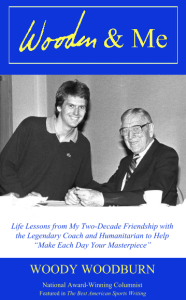 Check out my new memoir WOODEN & ME: Life Lessons from My Two-Decade Friendship with the Legendary Coach and Humanitarian to Help “Make Each Day Your Masterpiece”
Check out my new memoir WOODEN & ME: Life Lessons from My Two-Decade Friendship with the Legendary Coach and Humanitarian to Help “Make Each Day Your Masterpiece”
- Personalized signed copies are available at WoodyWoodburn.com
- Unsigned paperbacks or Kindle ebook can be purchased here at Amazon

